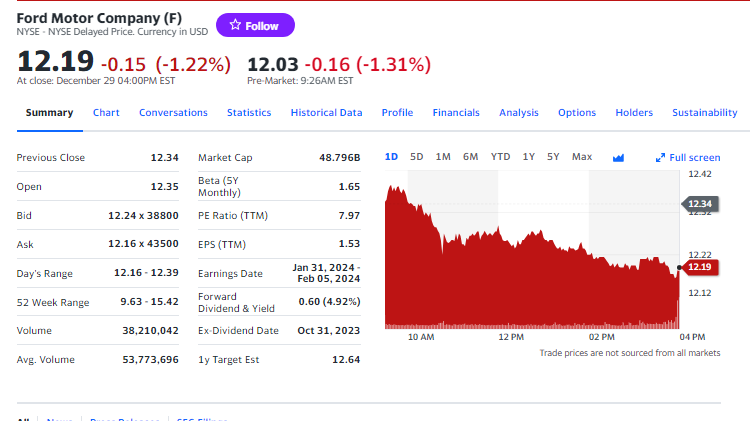This website and its content are not intended to provide professional or financial advice. The views expressed here are based solely on the writer’s opinion, research, and personal experience, and should not be taken as factual information. The author is not a financial advisor and lacks relevant certifications in that regard. We highly recommend consulting a qualified financial advisor before making any investment decisions, as the information presented on this site is general in nature and may not be tailored to individual needs or circumstances.
As we embark on an analysis of Ford’s stock performance, it’s crucial to acknowledge the company’s current market standing. With a closing price of $12.19 and a slight pre-market decrease to $12.06, Ford’s stock exhibits a dynamic yet resilient character in the market. This resilience is mirrored in the company’s broad portfolio, which includes traditional combustion engine models under Ford Blue and innovative electric vehicles (EVs) under Ford Model e.
The recent years have seen Ford navigating through a transformative phase, particularly with its commitment to electric vehicles. This transition is not just a response to evolving consumer preferences but also a strategic move to stay competitive and relevant in a rapidly changing automotive landscape.
Ford’s market share and financial health have been impacted by various factors, including the global chip shortage, shifts in consumer behavior, and evolving industry standards. Despite these challenges, Ford maintains a significant presence in key markets, holding about 13% market share in the United States, 6.5% in Europe, and 2.1% in China, including unconsolidated affiliates.
Understanding Ford’s current market position is essential in evaluating its stock price and investment potential. The company’s efforts in innovation and adaptation to market trends suggest a forward-looking approach, making it an intriguing subject for investors and analysts alike. As we proceed with a detailed analysis of Ford’s stock performance, these factors will serve as a foundation for a comprehensive understanding of its current and future potential in the stock market.

Historical Stock Performance Review
Ford’s stock performance over the recent years has been marked by a series of ups and downs, reflecting the company’s ongoing efforts to navigate the complexities of the automotive industry. The stock has shown resilience in the face of various market challenges, including global supply chain disruptions and the transition to electric vehicles.
- Short-term Trends: Over the past month, Ford’s stock has seen a notable increase, climbing by over 15% from a low of $10.18 to a high of $12.50. This uptick indicates a positive market reaction to the company’s strategic moves and overall industry trends.
- Long-term Analysis: Looking at a broader timeline, over the past two years, Ford’s stock has experienced significant fluctuations. The stock hit a high of $25.87 but also saw a low point of $9.63, indicating a period of volatility. However, over a three-year period, the stock has shown an overall upward trend, with an increase of approximately 38.68% from a low of $8.43.
- Comparative Analysis: When compared to its historical performance, the current stock price of $12.19 reflects both the challenges and opportunities the company faces. For instance, five years ago, the stock was valued significantly lower, at around $3.96, showing a substantial growth of over 200% to its peak in the past five years.
- 52-Week Performance: In the last 52 weeks, the stock reached its highest at $15.42 and its lowest at $9.63. This range provides insight into the stock’s volatility and the potential for growth and decline within a year.

This analysis of Ford’s stock performance is crucial in understanding the company’s market dynamics and investment potential. The historical data reflects Ford’s resilience and adaptability in a rapidly evolving industry. For investors, this historical perspective provides a foundational understanding of Ford’s stock behavior and potential future trends.
Financial Highlights and Earnings Overview
Ford’s financial health is a critical aspect of its stock analysis. A thorough examination of its earnings reports, revenue trends, and profitability metrics provides valuable insights into the company’s operational efficiency and financial stability.
Recent Earnings Reports
Ford’s latest earnings reports show a complex financial picture. The company has faced challenges such as increased production costs and supply chain disruptions, yet it has also benefited from strong demand in key markets.
Revenue Trends
Ford’s revenue generation has been influenced by several factors, including its performance in different global markets, the impact of new model releases, and its investment in electric vehicles. The company’s revenue streams reflect its adaptability in the face of changing consumer preferences and technological advancements.
Profitability Metrics
Analyzing Ford’s profitability involves looking at key metrics such as net income, operating margin, and return on equity. These figures provide an understanding of how effectively the company is converting revenue into profits and how well it is managing its financial resources.
Earnings Per Share (EPS)
EPS is a crucial indicator of a company’s profitability. It reflects how much money a company makes for each share of its stock. Monitoring the trends in Ford’s EPS over time can offer insights into its financial health and future growth potential.
Debt and Liquidity
Ford’s balance sheet, specifically its debt levels and liquidity position, is essential for assessing its financial resilience. The company’s ability to manage its debt and maintain sufficient liquidity is vital for sustaining operations and funding growth initiatives.
Comparison with Industry Averages
To contextualize Ford’s financial performance, it’s useful to compare its key financial metrics with industry averages. This comparison helps in understanding how Ford is performing relative to its peers in the automotive industry.
By examining these financial highlights and earnings details, investors can better gauge Ford’s financial health and its ability to sustain and grow in the competitive automotive market. This financial overview is an integral part of understanding Ford’s stock value and potential as an investment option.
Impact of Electric Vehicle Transition
The shift towards electric vehicles (EVs) is a defining movement in the automotive industry, and Ford has been actively participating in this transition. This section explores how Ford’s pivot to electric vehicles is influencing its stock value and overall market position.
Embracing the Electric Future
Ford’s investment in electric vehicles is a strategic response to the growing demand for sustainable and environmentally friendly transportation options. The company’s commitment is evidenced by its launch of popular models such as the Mustang Mach-E and the all-electric F-150 Lightning.
Financial Implications of the EV Shift
Transitioning to electric vehicles requires significant capital expenditure. Ford’s financial commitment to EV development impacts its short-term profitability but is expected to drive long-term growth. The success of its EV lineup will be a key determinant of its future revenue streams and market share.
Market Response and Consumer Adoption
The market’s response to Ford’s electric vehicles is crucial. Early signs indicate strong consumer interest, as seen in the pre-orders and positive reviews for its new electric models. Continued consumer adoption of Ford’s EVs is essential for the success of this strategic shift.
Competition in the EV Arena
Ford faces stiff competition in the EV market from established players like Tesla and emerging competitors. The company’s ability to innovate and offer competitive pricing and features is critical to gaining a significant foothold in the EV segment.
Regulatory Impact and Incentives
Government policies and incentives for electric vehicles can greatly influence Ford’s success in this area. Favorable regulations and subsidies for EVs can accelerate consumer adoption and improve Ford’s competitive position.
Environmental and Sustainability Considerations
Ford’s shift to electric vehicles aligns with global efforts to reduce carbon emissions. This not only helps in meeting environmental goals but also appeals to environmentally conscious consumers and investors.
Challenges and Opportunities
While the transition presents challenges like high development costs and intense competition, it also opens up opportunities for growth, innovation, and leadership in a future-oriented industry.
The move towards electric vehicles is a critical component of Ford’s future strategy. This transition is not without its challenges, but it holds the promise of revitalizing the brand and positioning Ford as a leader in the evolving automotive landscape.
Competitive Landscape and Industry Comparison
Ford Motor Company operates in a highly competitive automotive industry, contending with both traditional automakers and newer entrants focused on electric vehicles (EVs). This competition is pivotal in shaping Ford’s market position and influencing its stock performance.
Ford vs. Traditional Automakers
Ford’s primary competitors include established automotive giants like General Motors, Volkswagen, and Toyota. These companies share similar challenges, including supply chain complexities, regulatory compliance, and the need to innovate in the face of evolving consumer preferences. However, each has distinct strategies and strengths, impacting their market share and financial performance.
- General Motors (GM): GM has been aggressively investing in electric and autonomous vehicles, aiming to transition to an all-electric future. GM’s investment strategy and product lineup may impact Ford’s market positioning, especially in the EV sector.
- Toyota: Known for its efficiency and reliability, Toyota has a strong global presence. While slower to adopt electric vehicles, Toyota’s dominance in hybrid technology poses a significant challenge to Ford.
- Volkswagen: With substantial investments in electrification, Volkswagen is rapidly expanding its EV portfolio, directly competing with Ford’s electric models.
Emerging Competitors in the Electric Vehicle Market
The automotive industry is witnessing a surge in new entrants, primarily focused on electric vehicles. These companies, like Tesla, Rivian, and Nio, represent a significant shift in the competitive landscape.
- Tesla: As a leader in the EV market, Tesla’s innovative approach and strong brand appeal set a high bar for Ford’s EV initiatives.
- Rivian: Specializing in electric trucks and SUVs, Rivian directly competes with Ford’s electric versions of its iconic models like the F-150.
- Nio: This Chinese EV manufacturer is expanding globally, potentially impacting Ford’s market share in crucial regions.
Industry Comparison: Market Share and Growth
A comparative analysis of market share and growth trajectories provides insights into Ford’s competitive stance. For instance, while Ford holds a significant share in the truck and SUV segments, its position in the EV market is still developing. Comparing sales volumes, revenue growth, and market penetration rates between Ford and its competitors offers a clearer picture of its standing.
Strategic Alliances and Partnerships
Ford’s strategic partnerships, such as its collaboration with Volkswagen in autonomous and electric vehicles, play a crucial role in its competitive strategy. These alliances can enhance Ford’s technological capabilities, expand its market reach, and provide cost efficiencies.
The competitive landscape in the automotive industry is complex and rapidly evolving, particularly with the shift towards electric vehicles. Ford’s position, while strong in certain traditional segments, faces significant challenges and opportunities in the EV arena. Understanding these dynamics is crucial for investors assessing Ford’s future prospects in a shifting market.
Investor Sentiment and Market Predictions for Ford
Investor sentiment and market predictions are critical factors in understanding the future trajectory of Ford’s stock. These elements reflect the confidence and expectations of investors based on current trends, financial health, and future prospects of the company.
Current Investor Sentiment
Investor sentiment towards Ford can be gauged through various indicators, such as stock analyst ratings, investor forums, and market surveys. As of 2024, the sentiment has been cautiously optimistic, influenced by Ford’s strategic moves towards electrification and its resilience in a competitive market. However, concerns about global economic conditions and supply chain disruptions continue to add an element of caution.
Analyst Ratings and Recommendations
Financial analysts play a significant role in shaping investor sentiment. Ratings and recommendations for Ford’s stock typically range from “buy” to “hold,” indicating a general positive outlook with some reservations. Analysts cite Ford’s strong brand, loyal customer base, and growth in the electric vehicle segment as positive factors. Conversely, challenges in global expansion and market competition from EV-focused companies are areas of concern.
Market Predictions for Ford’s Future
Looking ahead, several factors are likely to influence Ford’s market performance:
- EV Market Expansion: Ford’s commitment to electrifying its fleet, including popular models like the Mustang Mach-E and the F-150 Lightning, is expected to boost its market share in the EV sector. The success of these models is crucial for Ford’s growth.
- Global Economic Conditions: Economic factors such as interest rates, inflation, and consumer spending patterns will impact the automotive industry as a whole, affecting Ford’s sales and profitability.
- Technological Innovations: Advances in autonomous driving, battery technology, and sustainable manufacturing processes are areas where Ford needs to excel to stay competitive.
- Regulatory Changes: Environmental regulations and policies promoting electric vehicles will benefit Ford, provided it continues to invest in and develop its EV lineup.
While the future of Ford’s stock is subject to various external and internal factors, the general market prediction leans towards cautious optimism. The company’s pivot towards electric vehicles and its established market presence position it well for future growth, though not without challenges from economic uncertainties and intense industry competition. Investors are advised to keep a close eye on industry trends, Ford’s strategic decisions, and broader economic indicators to make informed investment decisions.
Frequently Asked Questions
Ford faces competition from traditional automakers like General Motors and Toyota, as well as newer EV-focused companies like Tesla. Its market share, growth in the electric vehicle segment, and strategic partnerships are crucial in its comparison with these competitors.
Recently, Ford’s stock has shown resilience with a notable increase over the past month, climbing over 15% from a low of $10.18 to a high of $12.50. This uptick reflects positive market reactions to Ford’s strategic decisions, particularly in the electric vehicle (EV) sector. Long-term analysis indicates significant fluctuations but an overall upward trend over three years, with a 38.68% increase from a low of $8.43.
Ford is actively adapting to the electric vehicle market by investing in and launching new EV models like the Mustang Mach-E and the all-electric F-150 Lightning. This transition, while requiring significant capital expenditure, positions Ford to leverage the growing demand for sustainable transportation and align with environmental goals.
Conclusion
Reflecting on Ford Motor Company’s stock performance and market dynamics, it’s evident that the company stands at a pivotal crossroads. With its current stock price of $12.19 and a market share holding steady in key regions, Ford demonstrates resilience amid challenges like the global chip shortage and shifts in consumer behavior.
The company’s strategic pivot towards electric vehicles, notably with its Ford Model e lineup, signals a proactive approach to industry evolution and consumer demands. While recent fluctuations in stock value, showing a 38.68% increase over three years, hint at volatility, they also underscore Ford’s adaptability in a competitive and rapidly changing automotive landscape.
Financial analyses reveal a complex yet promising picture, balancing the costs of transitioning to electric vehicles against potential long-term gains. As Ford navigates the intricate balance of maintaining its stronghold in traditional markets while embracing the electric future, its financial health and strategic alliances remain key factors. The investor sentiment, cautiously optimistic, reflects confidence in Ford’s brand strength and EV initiatives, tempered by broader economic and industry challenges.
Ultimately, Ford’s ongoing efforts to innovate and adapt are central to its potential for sustained growth and market leadership in an increasingly electric-driven automotive world.
StockHax strives to provide unbiased and reliable information on cryptocurrency, finance, trading, and stocks. However, we cannot provide financial advice and urge users to do their own research and due diligence.
Read More


